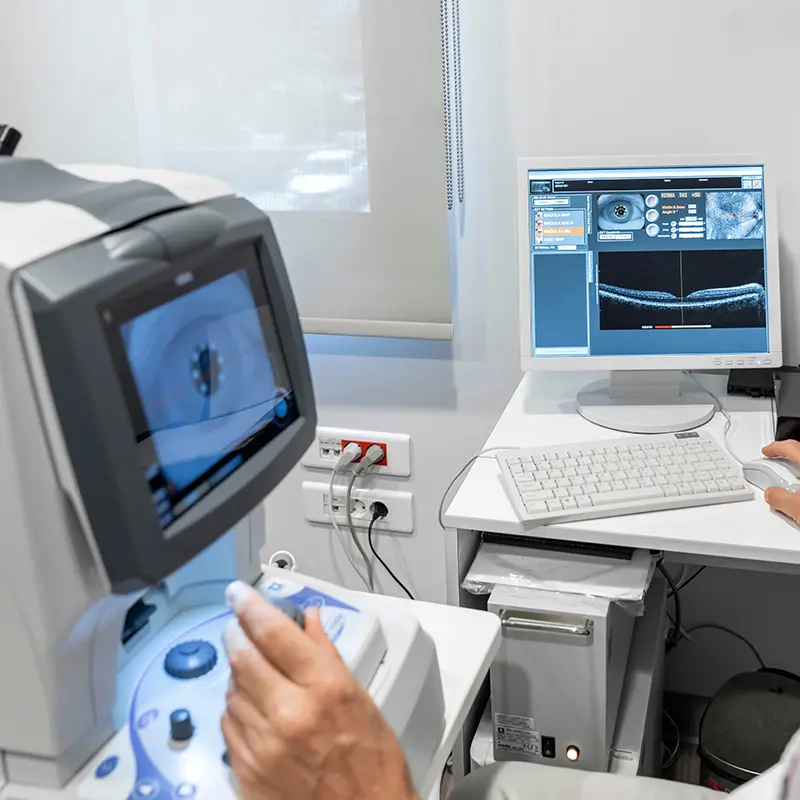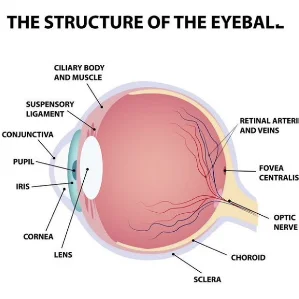“Inherited retinal diseases” is a term for a group of progressive retinal diseases that cause vision loss or blindness and are caused by mutated or malfunctioning genes. These rare diseases necessitate treatment by experts, and the doctors at Retina Specialty Institute are among the few with the qualifications and experience needed to diagnose and manage them. We are proud to be the first—and only—stop for inherited retinal disease patients from Northwest Florida, Mississippi, Alabama and throughout the Gulf Coast.

What is an Inherited Retinal Disease?
An inherited retinal disease (IRD), sometimes referred to as inherited retinal dystrophy or genetic retinal disease, is the result of DNA abnormalities (mutations). These mutations may be inherited, or they could be random. Inherited retinal diseases are rare, and can affect people of all ages. Most IRDs are degenerative, which means that symptoms progressively worsen with time and
Trusted Source
What are Inherited Retinal Diseases (IRDs)?
Prevent Blindness
Go to Source
cause severe vision loss or blindness
.

What Causes IRDs?
Trusted Source
What are Inherited Retinal Diseases (IRDs)?
Prevent Blindness
Go to Source
Inherited retinal diseases are caused by a variant
or change in one or multiple genes that cause proteins not to be made or to be made incorrectly. This can cause cells in the retina to degenerate, which is why IRDs are progressive. To date, more than 260 genes have been identified as causes of inherited retinal diseases. Identifying the gene or genes behind a patient’s IRD is essential to a correct diagnosis and effective treatment. Knowing which gene or gene causes a patient’s inherited retinal disease can also help their ophthalmologist recommend them for clinical trials where new therapies are in development.
Symptoms of Inherited Retinal Diseases
Each IRD has distinct symptoms, but vision loss is common to all of them. Other common symptoms of retinal degeneration and IRDs include:
- Loss of peripheral vision
- Loss of central vision
- Loss of color vision
- Light sensitivity
- Trouble seeing in low light (night blindness)
Common Inherited Retinal Diseases
There are many variations of inherited retinal diseases, but some (though rare) are more common than others.
Retinitis Pigmentosa
Retinitis pigmentosa (RP) is a group of diseases that affect the retina. In patients with retinitis pigmentosa, light-sensing retinal cells (photoreceptor cells) degrade over time, leading to vision. Most patients display symptoms of retinitis pigmentosa in
Trusted Source
Retinitis Pigmentosa
National Eye Institute
Go to Source
early childhood
, such as loss of night vision, loss of peripheral vision, light sensitivity, and loss of color vision. As RP progresses, patients often experience blind spots and loss of central vision.
Choroideremia
Choroideremia is an inherited retinal disease that
Trusted Source
Choroideremia
National Institute of Health, Genetic and Rare Diseases Information Center
Go to Source
mostly affects males
. In patients with choroideremia, cells in the retina and the associated network of blood vessels (choroid) degenerate and die. Symptoms of this disease often begin with night blindness in a patient’s early childhood, then progress to tunnel vision and an inability to identify details (decreased visual acuity).
Stargardt Disease
Stargardt disease causes fatty material to accumulate on the macula. The macula is the central part of the retina, and it is responsible for central vision. In patients with
Trusted Source
Stargardt Disease
National Eye Institute
Go to Source
stargardt disease
, vision begins to decline in childhood and slowly progresses. Other symptoms of Stargardt disease include spots in central vision, light sensitivity, difficulty adjusting to changes in light, and color blindness.
Cone-Rod Dystrophy
Cone-rod dystrophy is the name for a number of inherited retinal disease that
Trusted Source
Cone-rod dystrophy
National Institute of Health, Genetic and Rare Diseases Information Center
Go to Source
affect the cones and rods
, the cells in the retina that are sensitive to light. These cones and rods progressively deteriorate and lead to vision loss. Symptoms of cone-rod dystrophy often present during childhood and include decreased vision sharpness and light sensitivity. Symptoms progress to include blind spots in central vision, loss of the ability to see colors, and loss of side (peripheral) vision.
Leber Congenital Amaurosis
Leber congenital amaurosis (LCA) is an inherited retinal disease that causes visual impairment and has a particularly early onset,
Trusted Source
Leber Congenital Amaurosis
National Institute of Health, Genetic and Rare Diseases Information Center
Go to Source
beginning in infancy
. Symptoms include light sensitivity, involuntary eye movements, and extreme farsightedness. In patients with Leber congenital amaurosis, the pupils react to light abnormally. Patients may also be diagnosed with keratoconus, a condition that causes the cornea to become increasingly cone-shaped and/or strabismus, which causes the eyes to look in different directions.

How are IRDs Diagnosed?
The first step to diagnosing an inherited retinal disease is to gather a complete medical history from the patient as well as a family history. Next, a dilated eye exam will be performed. This may alert an eye doctor to changes in the retina, but even if a patient is symptomatic they may have normal retinal exam results. This is why ophthalmologists need to look further and conduct extensive testing to diagnose an IRD.
Tests that may be performed include:
- Visual Field Testing: This test helps eye doctors evaluate the patient’s vision for blind spots.
- Slit Lamp: During this test, an eye doctor uses a bright light and a microscope to examine parts of the eye.
- Electroretinogram (ERG): With this test, electrical activity in the macula’s rods and cones is evaluated.
- Fluorescein Angiography: This imaging technology allows the doctor to map the layers of the retina. If one or more of the layers are thin, it may be a result of damage from an IRD.
- Color Testing: Because many inherited retinal diseases affect the ability to see color, this is an important diagnostic test.
- Optical Coherence Tomography (OCT): This technology gives an eye doctor highly detailed images of the patient’s retina.

Genetic Testing for Inherited Retinal Diseases
In addition to vision tests and imaging technology, genetic testing may be essential to confirm the diagnosis and inform the treatment of an inherited retinal disease. A geneticist can identify the gene mutation or gene mutations responsible for a patient’s IRD, which can direct the patient’s care. A genetic diagnosis can also help inform patients about potential risks to organs that may be affected by an inherited retinal disease, and it can also help identify risks to their family members. Frequently, patients with an IRD work with a genetic counselor to understand the results of their genetic testing and the potential impact on other family members, including patients’ future children.
Treatment for Inherited Retinal Diseases
It is crucial that patients with inherited retinal diseases work closely with a retina specialist, as these experts have the greatest experience with treating IRDs. Patients with an inherited retinal disease may also work with a team of healthcare providers and social aids, including genetic counselors, low-vision specialists, school and education advocates, and social workers.
At this time, there are not approved treatments for all inherited retinal diseases. There are, however, a number of clinical trials directed towards identifying interventions, therapeutics, and methods to slow or stop the advance of specific IRDs, to restore sight to patients, or to advance retinal prosthetics, which can stimulate sight. Gene therapy is also a promising treatment avenue for many patients with inherited retinal diseases. At Retina Specialty Institute, our doctors are involved with a number of clinical trials and can direct patients with IRDs to trials most suitable for their diagnoses.

Contact Retina Specialty Institute
Inherited retinal diseases require the treatment of a highly experienced specialist. At Retina Specialty Institute, our practice is dedicated to the treatment of all forms of retinal diseases and disorders. Our experts have deep experience in the diagnosis and management of inherited retinal diseases.
1 Prevent Blindness. What are Inherited Retinal Diseases (IRDs)? Available: https://preventblindness.org/inherited-retinal-diseases/. Accessed August 18, 2022.
2 Prevent Blindness. What are Inherited Retinal Diseases (IRDs)? Available: https://georgia.preventblindness.org/inherited-retinal-diseases/. Accessed August 18, 2022.
3 National Eye Institute. Retinitis Pigmentosa. Available: https://www.nei.nih.gov/learn-about-eye-health/eye-conditions-and-diseases/retinitis-pigmentosa#:~:text=Retinitis%20pigmentosa%20(RP)%20is%20a,that%20people%20are%20born%20with. Accessed August 18, 2022.
4 National Institute of Health, Genetic and Rare Diseases Information Center. Choroideremia. Available: https://rarediseases.info.nih.gov/diseases/6061/choroideremia. Accessed August 18, 2022.
5 National Eye Institute. Stargardt Disease. Available: https://www.nei.nih.gov/learn-about-eye-health/eye-conditions-and-diseases/stargardt-disease#:~:text=Stargardt%20disease%20is%20a%20rare,vision%20until%20they%27re%20adults. Accessed August 18, 2022.
6 National Institute of Health, Genetic and Rare Diseases Information Center. Cone-rod dystrophy. Available: https://rarediseases.info.nih.gov/diseases/10790/cone-rod-dystrophy. Accessed August 18, 2022.
7 National Institute of Health, Genetic and Rare Diseases Information Center. Leber Congenital Amaurosis. Available: https://rarediseases.info.nih.gov/diseases/634/leber-congenital-amaurosis. Accessed August 18, 2022.
The doctors at Retina Specialty Institute have either authored or reviewed and approved this content.
Page Updated:







